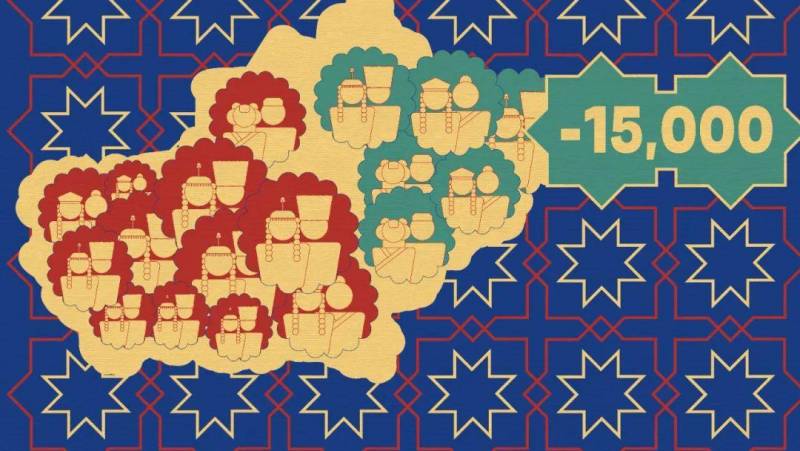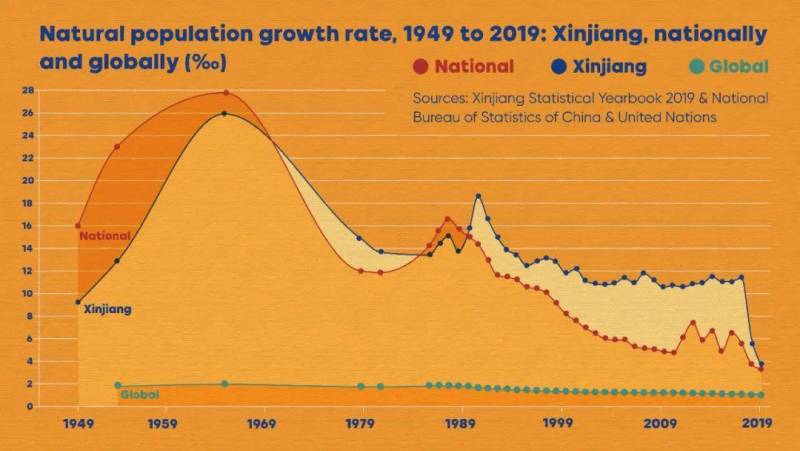A vast, hot , , , snowy … There are so many of the Uygur to be .广袤无垠的大漠,精美的佛教石窟,严寒的皑皑雪山……新疆维吾尔自治区有太多值得我们探寻。
, has been fixed on the ’s in .
然而,最近几个月,国际注意力却紧紧聚焦在这个地区的人口数量上。

Among the , the in has been the most high . That’s the data shows the rate - from 11.4 per in 2017 to 6.13 per in 2018.
在众多争议中,新疆人口的逐年变化最引人注目。官方数据显示,当地人口2017年到2018年的自然增长率从千分之11.4下降至6.13。
The size of the has wild . Yet the rate in than the level, the ’s trend is the model, and the in the data are with local and .
如此大规模的下降引发了各种猜测,然而新疆的人口增长率依然明显高于中国的整体水平。并且,当地的人口发展趋势与全球人口的转变趋势也相符;同时,新疆人口数据的变化还反映了当地政策与人们观念的最新转变。
Let’s explore these factors through statistics.
让我们通过数据来抽丝剥茧。
Firstly, the policies in the region related to births.
首先,我们来了解下新疆的生育政策。
have lived in oases the Tarim Basin, south of . by the as an , they are in fact the group in the .
有史以来,维吾尔族一直散居在天山以南塔里木盆地周围的绿洲里。尽管被中国政府认定为少数民族,但他们其实是该自治区人口最多的民族。
From the 1970s, a of . While Han in the had more on , like had by a base.
从20世纪70年代开始,一系列计划生育政策加速了新疆的人口结构转变。当地的汉族人在生育方面面临更严格的政策要求,而包括维吾尔族在内的少数民族拥有更大的人口基数,从而推动了更强劲的人口增长。
As a , the gap two as time went on.
结果,少数民族和汉族之间的人口差距随时间推移逐渐拉大。
In terms of the rate in 2018, it was in the year that the of Uygur on and were for the first time since 2010.
至于2018年新疆人口生长率的大幅下降,则与前一年《新疆维吾尔自治区人口与计划生育条例》在2010年版本后的首次更新有关。
The new rules no Han from , and all in urban areas could have up to two kids, while those in rural areas could have no more than three. The who didn’t the rules faced legal , while those who stuck to them were for more cash .
新规定不再区别对待汉族和少数民族,所有城镇地区的家庭可以最多生育两个孩子,而农村地区的家庭最多可以生育三个。没有遵循规定的夫妻将承担更严重的法律责任,而那些遵守条例的夫妻则有资格领取更多现金奖励。
Early and early are less in and China.There were 120,000 fewer in from 2017 to 2018. In the same , there were over 15,000 fewer first , and over 29,000 more .
在新疆和中国其他各地,早婚早育的现象越来越少。从2017年到2018年,新疆新生儿减少了约12万人。同期,初婚登记减少了1.5万多对,颁发的计划生育证书增加了2.9万多张。

, the of a area be with the size of its and . ’s low level of and , as well as its and of water , means a low .
第二,一个地区的人口数量应该与它的经济体量与资源规模相匹配。新疆的工业化和城市化水平相对较低,水资源短缺且分布不均衡,这些因素都不可避免地导致了较低的人口密度。
Take South as an . The was 8.08 per from 1998 to 2006, lower than the level, it the of seven per for an arid .
以南疆地区为例,1998年到2006年期间,当地的实际人口密度为每平方公里8.08人。尽管低于全国水平,但这个数字已经超过了干旱区每平方公里7人的人口密度临界值。

, at the trend, ’s with the model – after a of .
第三,从总体趋势来看,新疆的人口自然增长与全球范围的人口转变模式相一致——即在经历了一段时期的增长之后,目前的人口自然生长率是下降的。
, on and , ’s on human labor, as well as and , have led us to the stage: a low rate, built on the of a birth rate and lower death rate.
从全球角度看,医学技术和卫生条件的划时代进步、工业生产对人力依赖的减少,以及人们婚育态度的转变,这一系列因素都导致我们进入了当前的人口发展阶段,那就是由走低的出生率和更低的死亡率促成的低人口自然增长率。
than the in , we on how to the for its , and the to the local and of life.
与其去争论新疆的人口数量问题,我们不如把精力放在为当地人民构筑更美好的未来上,以可持续的方式推动发展,从而保护当地环境,并提升人们的生活水平。









